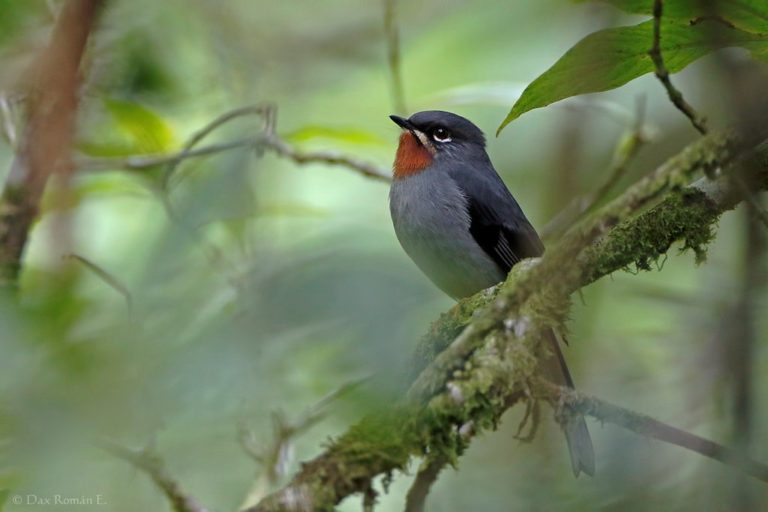Birdfinding.info ⇒ Locally common, but much more easily heard than seen. In the Dominican Republic, easiest to find at Cachote, Zapotén, and Ébano Verde. In Haiti, it is common in Pic Macaya Biosphere Reserve and La Visite National Park. On Dominica, it can usually be found along the Syndicate Trail, at Emerald Pool, and throughout Morne Tres Pitons National Park. On Martinique, it is common in the eastern foothills of the Carbet Mountains, especially around Fonds-St.-Dénis. On St. Lucia, Edmund and Quilesse Forest Reserves and Des Cartier Rainforest Trail are reliable sites.
Rufous-throated Solitaire
Myadestes genibarbis
Endemic to the West Indies, where it occurs in wet montane forests. The six subspecies are each endemic to one island: Jamaica (solitarius), Hispaniola (montanus), Dominica (dominicanus), Martinique (genibarbis), St. Lucia (sanctaeluciae), and St. Vincent (sibilans).
“Jamaican Solitaire” and “St. Vincent Solitaire” are visibly distinct forms and candidates for recognition as separate species. In the case of the “Jamaican Solitaire,” genetic research supports this recognition; the genetic isolation of “St. Vincent Solitaire” has not been studied.
On Hispaniola, it occurs mainly at upper elevations of the Cordillera Central, Cordillera Septentrional, Sierra de Neiba, Sierra de San Martín, Sierra de Bahoruco, Massif de la Hotte, and Massif de la Selle, and has also been reported at lower elevations on the Samaná Peninsula and in Los Haitises National Park.
Identification
The typical form—which consists of the subspecies of Hispaniola, Dominica, Martinique, and St. Lucia—has slate-gray upperparts and pale gray underparts, with a bright rufous throat and rusty belly and vent. Its face is boldly marked with white on the chin, whisker, and below the eye.

Rufous-throated Solitaire, M. g. montanus. (Ébano Verde Scientific Reserve, Dominican Republic; March 24, 2016.) © Dax M. Román E.
The outer tail feathers are largely white (visible mainly in flight or from below), and the spread wing shows a white bar at the base of the flight feathers.
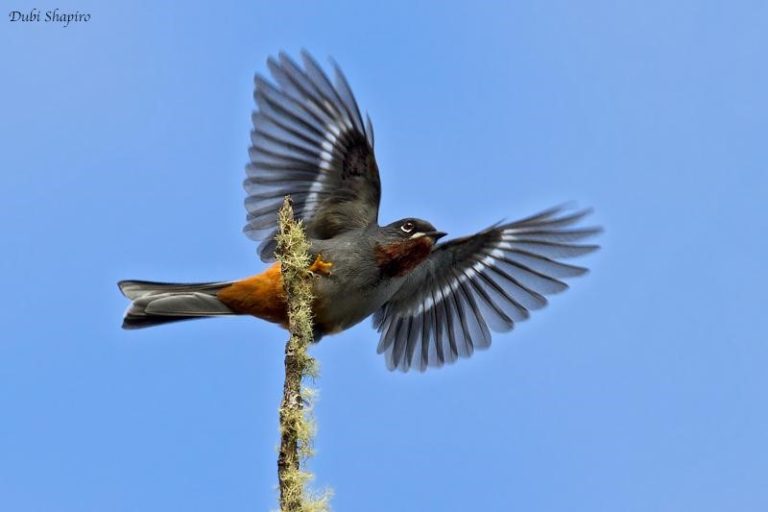
Rufous-throated Solitaire, M. g. montanus, showing the white bar at the base of the flight feathers. (Sierra de Bahoruco, Dominican Republic; January 31, 2014.) © Dubi Shapiro
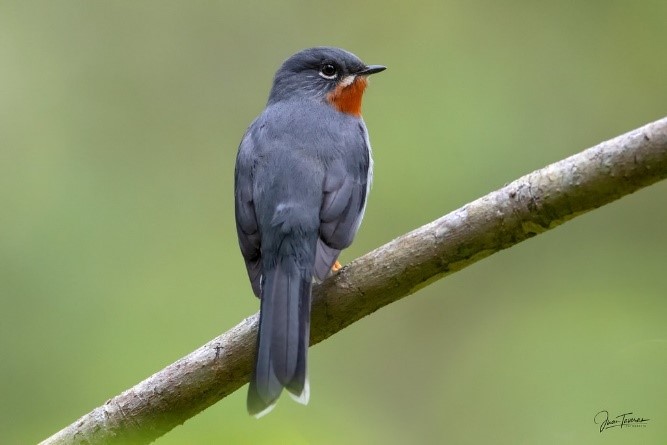
Rufous-throated Solitaire, M. g. montanus, showing white edge on folded tail. (Ébano Verde Scientific Reserve, Dominican Republic; February 2, 2019.) © Juan Taveras
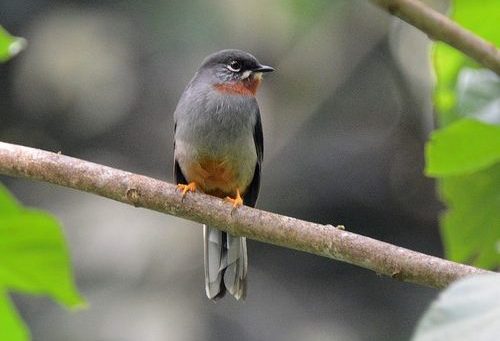
Rufous-throated Solitaire, M. g. dominicanus, showing white undertail and bright orange legs. (Des Cartiers Rainforest Trail, Micoud, St. Lucia; November 26, 2015.) © Kyle Kittelberger
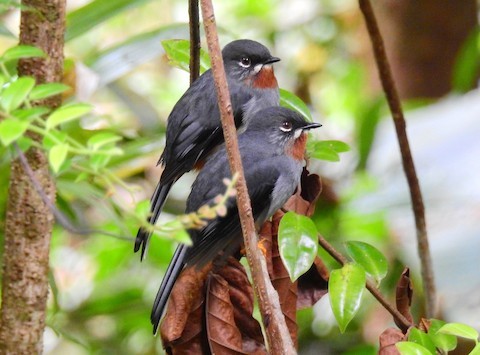
Rufous-throated Solitaire, M. g. sanctaeluciae. (Quilesse Forest Reserve, Micoud, St. Lucia; March 1, 2019.) © Robert Curry

Rufous-throated Solitaire, M. g. montanus. (Ébano Verde Scientific Reserve, Dominican Republic; July 5, 2015.) © Dax M. Román E.

Rufous-throated Solitaire, M. g. montanus. (Ébano Verde Scientific Reserve, Dominican Republic; July 5, 2015.) © Dax M. Román E.
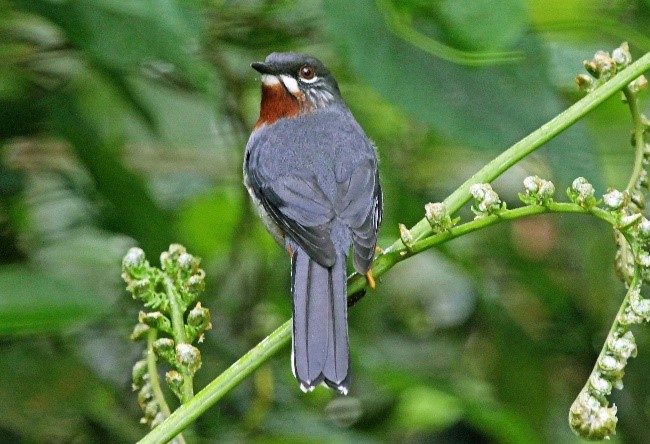
Rufous-throated Solitaire, M. g. dominicanus, showing bold white facial markings (Syndicate Trail, Morne Diablotin National Park, Dominica; April 10, 2013.) © Greg Griffith

Rufous-throated Solitaire, M. g. montanus, showing bright orange legs. (Ébano Verde Scientific Reserve, Dominican Republic; February 2, 2019.) © Juan Taveras

Rufous-throated Solitaire, M. g. montanus. (Sierra de Bahoruco, Dominican Republic; August 31, 2013.) © Dax M. Román E.
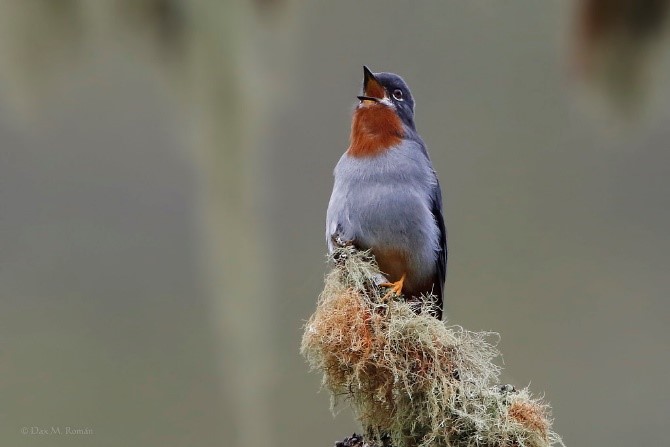
Rufous-throated Solitaire, M. g. montanus, in full song. (Sierra de Bahoruco, Dominican Republic; May 17, 2016.) © Dax M. Román E.
Among the four typical subspecies, the nominate genibarbis of Martinique differs in that the rusty coloration on its belly often extends up to the middle of the breast.
The other three (montanus, dominicanus, and sanctaeluciae) are internally variable: some individuals have almost entirely gray bellies, while others have mostly rusty bellies.
The two more distinct forms (not shown here) have clear distinguishing features:
“Jamaican Solitaire” has no white on its chin and, instead of a white whisker, has only a white speck at the base of the bill.
“St. Vincent Solitaire” is the most visibly divergent form, with blackish upperparts, pale gray underparts, olive-gray rump, pale rusty throat and vent, and a faint dark whisker stripe.

Rufous-throated Solitaire, M. g. genibarbis, showing the extensively rusty belly that is typical of this subspecies. (Martinique; April 2018.) © Pierre Crouzier
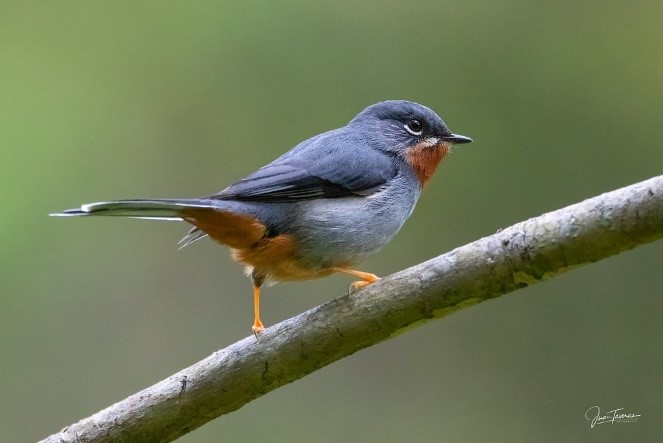
Rufous-throated Solitaire, M. g. montanus. (Ébano Verde Scientific Reserve, Dominican Republic; February 2, 2019.) © Juan Taveras
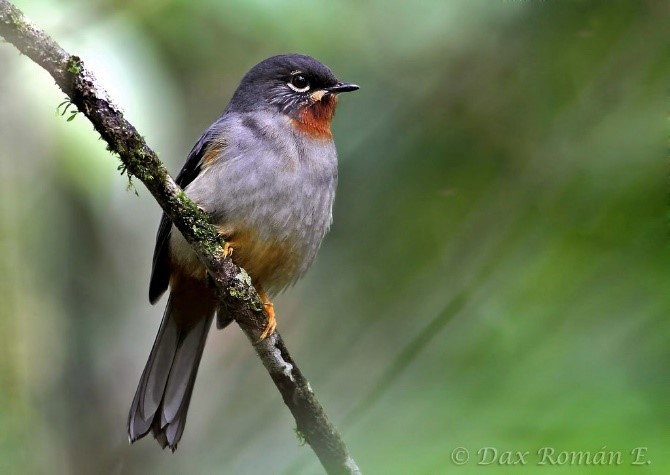
Rufous-throated Solitaire, M. g. montanus. (Los Arroyos, Dominican Republic; January 18, 2012.) © Dax M. Román E.
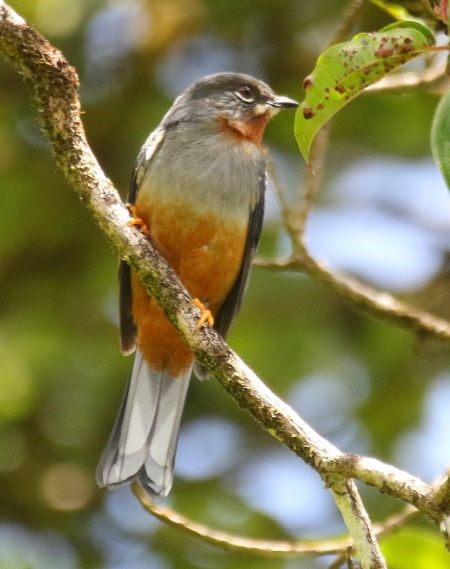
Rufous-throated Solitaire, M. g. genibarbis, showing the extensively rusty belly that is typical of this subspecies. (Martinique; April 2018.) © Pierre Crouzier
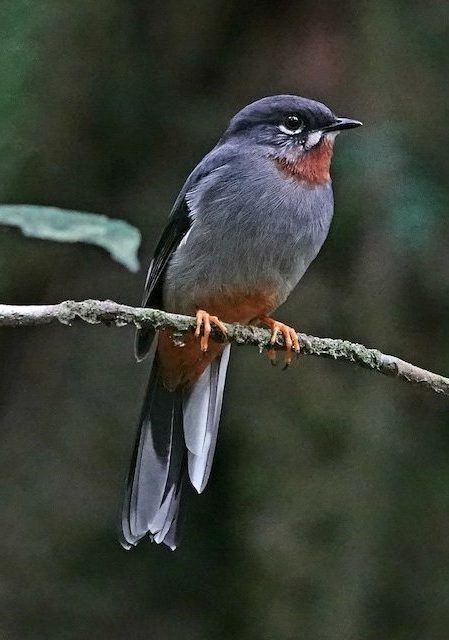
Rufous-throated Solitaire, M. g. sanctaeluciae. (Des Cartier Rainforest Trail, Micoud, St. Lucia; October 29, 2018.) © Kathleen Horn
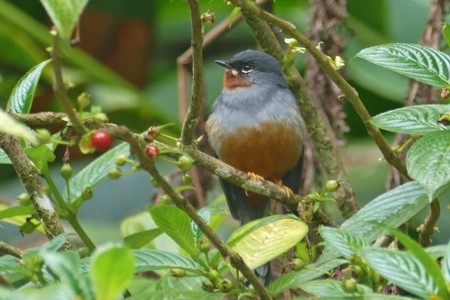
Rufous-throated Solitaire, M. g. genibarbis, showing the extensively rusty belly that is typical of this subspecies. (Martinique; May 2018.) © Marc Pommarel
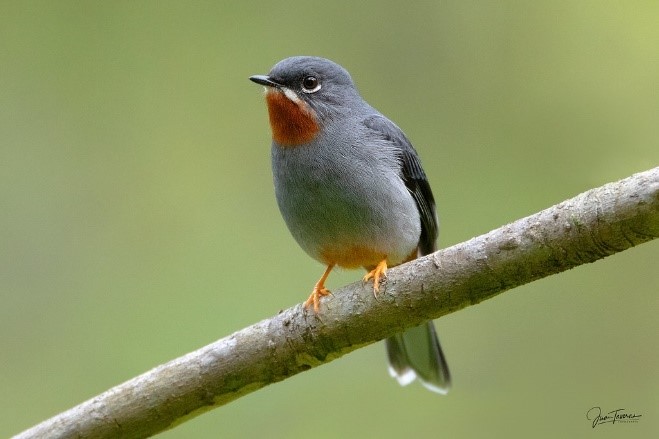
Rufous-throated Solitaire, M. g. montanus. (Ébano Verde Scientific Reserve, Dominican Republic; February 2, 2019.) © Juan Taveras
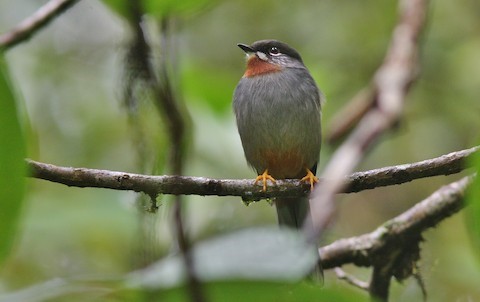
Rufous-throated Solitaire, M. g. dominicanus, showing mostly gray belly. (Morne Diablotin National Park, Dominica; January 8, 2015.) © Jim Tietz
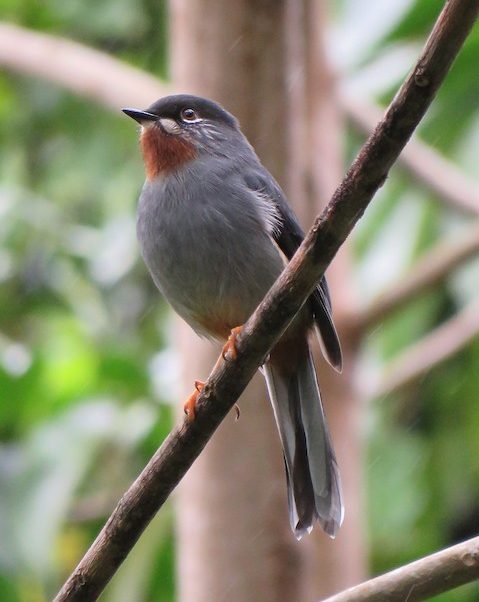
Rufous-throated Solitaire, M. g. dominicanus, showing mostly gray belly. (Syndicate, Dominica; December 21, 2016.) © Thomas Brooks

Rufous-throated Solitaire, M. g. dominicanus, showing mostly rusty belly. (Morne Diablotin National Park, Dominica; June 11, 2013.) © Angie Cederlund
Immature plumages are largely mottled blackish and rusty-brown.
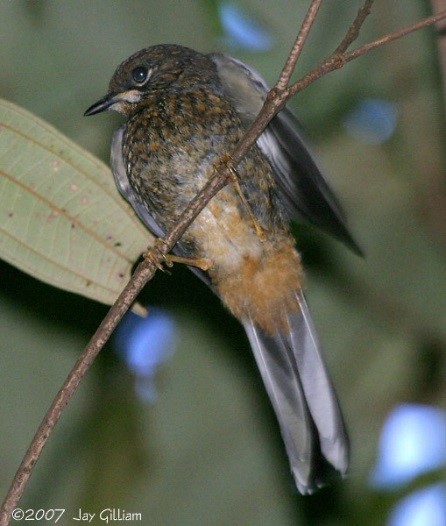
Black-crowned Palm-Tanager, immature—note gray crown, but all-white throat. (National Botanical Garden, Santo Domingo, Dominican Republic; April 15, 2017.) © Ricardo Tonos
Notes
Polytypic form consisting of six recognized subspecies, two of which are distinct forms and potentially separate species: “Jamaican Solitaire” (solitarius), and “St. Vincent Solitaire” (sibilans).
Frontiers of Taxonomy: the Rufous-throated Solitaire Complex. A mitochondrial DNA study (Miller et al. 2007) of Myadestes found that the “Jamaican Solitaire” is more distantly related to the subspecies of Hispaniola, Dominica, Martinique, and St. Lucia than these four are to one another. Remarkably, the study also found this distance to be greater than that between the Black-faced and Varied Solitaires of Central America—which suggests that “Jamaican Solitaire” is best regarded as a separate species. The researchers did not have access to tissue samples from the “St. Vincent Solitaire” and were therefore unable to analyze its genetic distance from the other subspecies.
References
Collar, N. 2017. Rufous-throated Solitaire (Myadestes genibarbis). In Handbook of the Birds of the World Alive (J. del Hoyo, A. Elliott, J. Sargatal, D.A. Christie and E. de Juana, eds.). Lynx Edicions, Barcelona. https://www.hbw.com/node/58239. (Accessed August 27, 2019.)
eBird. 2019. eBird: An online database of bird distribution and abundance. Cornell Lab of Ornithology, Ithaca, N.Y. http://www.ebird.org. (Accessed August 27, 2019.)
Haynes-Sutton, A., A. Downer, R. Sutton, and Y.-J. Rey-Millet. 2009. A Photographic Guide to the Birds of Jamaica. Princeton University Press, Princeton, N.J.
Latta, S., C. Rimmer, A. Keith, J. Wiley, H. Raffaele, K. McFarland, and E. Fernandez. 2006. Birds of the Dominican Republic and Haiti. Princeton University Press, Princeton, N.J.
Miller, M.J., E. Bermingham, and R.E. Ricklefs. 2007. Historical Biogeography of the New World Solitaires (Myadestes Spp.). Auk 124:868-885.
Raffaele, H., J. Wiley, O. Garrido, A. Keith, and J. Raffaele. 1998. A Guide to the Birds of the West Indies. Princeton University Press, Princeton, N.J.
